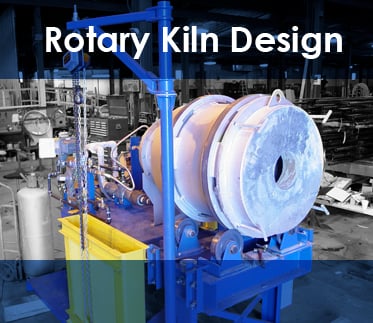Rotary kilns are a high-temperature thermal processing device used to cause a chemical reaction or phase change in a material. Able to process hundreds of materials, the applications in which rotary kilns can be used continue to grow – from the production of specialty chemicals, to the recovery of valuable components from wastes.
Despite their widespread use, however, all materials respond differently to the processing environment of a kiln. For this reason, rotary kilns must be designed around the exact characteristics of the material to be processed.
Not surprisingly, the specific heat and heat transfer properties of a material are one of the most important considerations to examine during kiln design, and will influence many factors in the design process. Additionally, a Thermal Gravimetric Analysis (TGA) or Differential Thermal Analysis (DTA) will be required to review the reaction parameters.
Thermal Analysis Data
The various material-specific data points examined in a thermal analysis are summarized below. These data points are typically available through published data. When dealing with a novel substance, this data can be gathered through testing.
Specific Heat
Specific heat refers to how resistant a material is to heating. By definition, it is how much energy it takes to raise 1 gram of material 1 degree Celsius. Some materials, such as water, have a very high specific heat, meaning it takes a significant amount of energy to raise the temperature. Other materials, such as metals, have a much lower specific heat, meaning it takes much less energy to cause a change in temperature.
Heat of Reaction
In many kiln applications, heat is required in order for a reaction to occur. For example, in the calcination of limestone to lime, energy is required to dissociate CaCO3 into CaO and CO2. In addition to energy, an elevated temperature is required for most reactions to occur; the dissociation of limestone will not happen at a temperature below 900° C.
The temperature and energy required for a reaction can be found in published data or by running a DTA test.
Thermal Conductivity (Heat Transfer)
Similar to specific heat, the thermal conductivity, or heat transfer properties of a material, also play a big part in the design of a rotary kiln. How a material transfers heat will have a direct effect on how the material behaves in the rotary kiln; will it transfer its heat easily, causing even heat distribution and low retention time, or will it hold onto its heat, causing cold pockets of material, a longer retention time, and possibly the need for additional accessories like dams or bed disturbers?
Thermal Gravimetric Analysis
A thermal gravimetric analysis is essential in evaluating the course of the intended reaction. A thermal gravimetric analysis, or TGA, can be performed on a material to determine changes in mass as a function of temperature and describes the temperature ranges at which mass loss occurs. This is critical in determining the required temperature profile in a kiln. For example, free water will show primary removal at around 212º F, where tightly bound chemical water may show a mass loss upwards of 500º F.
A TGA also helps show where a reaction begins, and ends, as often, the curve on a TGA starts at a specific temperature, but does not complete until a much higher temperature. Overall, a TGA helps determine the temperature profiles that will be required in a rotary kiln by showing at what temperature reactions are occurring. Additionally, while the intent of a process may be a specific reaction, a TGA will reveal reactions that might occur between the start and end point of the intended reaction, helping to indicate where unpredicted reactions may occur.
Differential Thermal Analysis
A Differential Thermal Analysis (DTA) or Differential Scanning Calorimeter (DSC), is also useful in the design stages, as it shows whether the reaction is endothermic or exothermic, and ultimately, the amount of heat required to perform the reactions and to heat the material to the final temperature.
Conclusion
As a high-temperature device, the analysis of a material’s thermal properties is the foundation of rotary kiln design. Factors such as a material’s specific heat, thermal conductivity, heat transfer properties, and more, will all influence how that material will behave in the kiln, and ultimately, how the kiln will need to be designed to work with the material’s properties and produce the desired result.
FEECO is a world leader in the design and fabrication of custom rotary kilns. Our unique testing facility, The Innovation Center, provides a broad range of test kilns for both batch and pilot-scale testing. For more information on our custom rotary kilns, contact us today!



